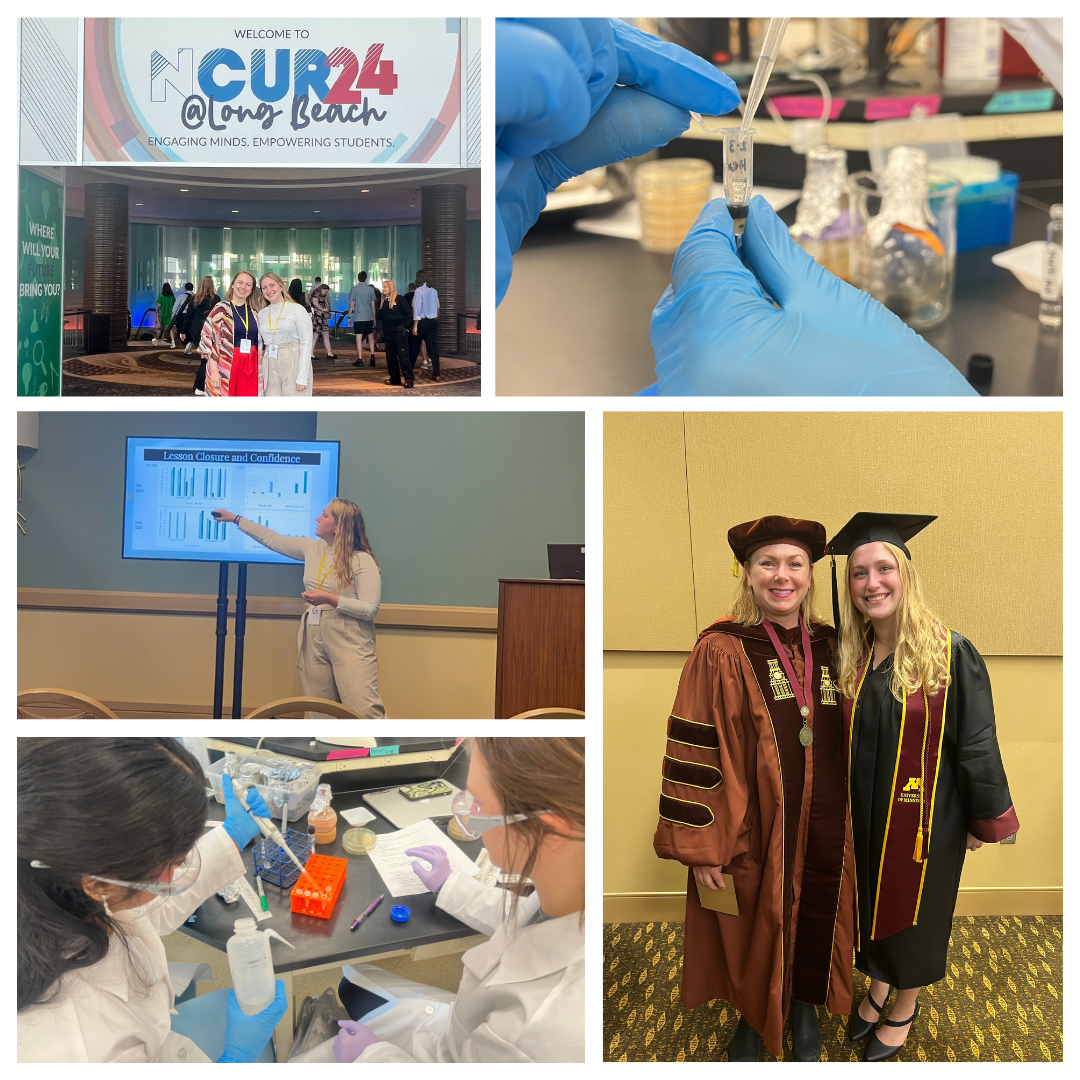Fostering Learning and Building Curriculum through Faculty and Student Collaboration
Authored By: wells438 07/22/2024
Lydia Miller, a 2024 graduate and Bachelor of Science in Health Sciences student at the University of Minnesota Rochester, wanted to take her learning to the next level.
In the spring of her third year, she enrolled in Biochemistry of Medicinal Plants, a course taught by Biochemistry professor Dr. Cassidy Terrell. While in class, Miller had an idea to further her growing interest in teaching and medicinal plants knowledge.
With the help of Dr. Terrell through a directed study and funding from the Undergraduate Research Opportunity Program, Miller developed a lab to coincide with the coursework in her Medicinal Plants class. The funding allowed Miller to dedicate her time to this project. As part of the grant’s requirement, Miller was also able to present her research at the National Conference for Undergraduate Research.
The labs were designed to allow students to physically conduct processes they were learning about while researching their plant. For example, while in lecture they were researching the ethnobotany, metabolites of interest, pharmacokinetics and mechanism of actions, in lab they were trying to extract and test the medicinal claims of the metabolites of interest for themselves.
Miller not only wanted to expand her and other student’s learning throughout the addition of the lab, but she also wanted to understand how students were learning in the lab.
She took the concept of lesson closure — a student-driven, short recap of the day's curriculum with students before the end of a class utilizing an instructor prompting Q & A where students can converse and collaborate to provide an answer — and applied this concept to a lab setting. While this concept is more often studied in lecture style classes, there is little to no application of it in a lab setting. Typically, labs end and students clean up and leave.
Since labs are typically complex environments requiring students to learn, be self aware in their surroundings and practice unfamiliar skills while implementing safety protocol, she felt this would be a great environment for lesson closure to help students prioritize learning. Specifically, help students learn and apply the theoretical concepts often missed in labs due to the amount student’s need to navigate in the lab environment.
This past spring, 15 students enrolled in Herbology: A Study of Medicinal Plants, the second version of the same course, and the coinciding lab. Miller was the Undergraduate Academic Assistant for the lab which allowed her to help students and conduct her research.
She created a three-tiered multiple choice question tool to help her track student learning focused on capturing student comprehension, retention and confidence of theoretical concepts.
“[The questions] are set up very strategically to try and avoid any multiple choice test answering strategies. The first tier is a multiple choice question about a theoretical concept of that lab, usually having four to five options. The second tier is always the question, ‘What reasoning best explains your answer above?’ In the second tier, there are correlating reasons for each answer choice in tier one, so all the answers could make sense. The third tier is just asking if the student is confident in their answers above,” shared Miller.
Curriculum was built so each lab meeting had a coinciding concept that they wanted students to take away from that day’s learning. The multiple choice questions given to students after lesson closure, or at the end of labs without lesson closure, centered around these targeted concepts.
Initial findings show that lesson closure may positively impact immediate learning and long-term understanding, as well as equip students with better distinction between information they understand and information of which clarification is needed. Miller presented her research and findings this spring at the National Conference for Undergraduate Research in Long Beach, California.
“This directed study validated the future direction I see myself going. I would love to teach, develop a new and hands-on curriculum like this for students to be able to explore interests as I was able to, and conduct research in the realm of medicinal plants/natural products,” shared Miller. Miller is now pursuing a PhD in Medicinal Chemistry at University of Minnesota Twin Cities.
As for Herbology: A Study of Medicinal Plants, Dr. Terrell plans to continue using this concept and tool as well as incorporate it into other labs at UMR.
“It's been a delight to work on this project with Lydia. Student perspectives and ideas are not often included in research on learning, this project would not have been possible without her involvement and her insights are invaluable,” shared Dr. Terrell.